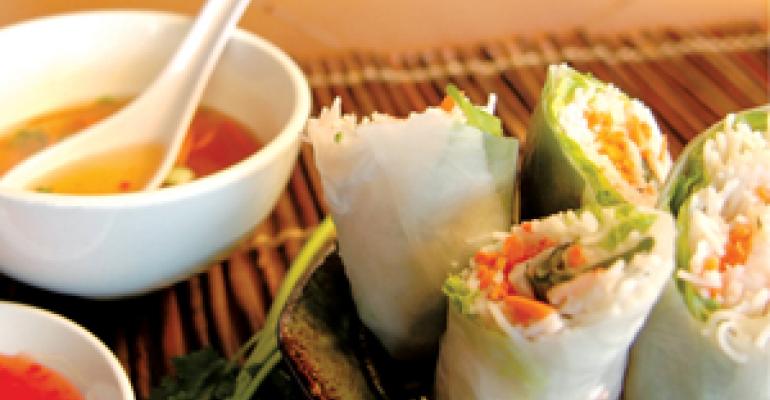The threat of food allergies hit close to home for the owners of the two-year-old Zydeco Kitchen & Cocktails in Bend, Ore., leading them to create an entire menu devoted to items free of gluten, a substance found especially in wheat and wheat products.
Celiac disease, also known as gluten intolerance, is a genetic disorder that affects about 1 percent of the Caucasian population, experts say. The autoimmune disorder can cause diarrhea, weight loss and fatigue as well as more severe reactions, experts say.
“My wife is celiac,” says Stephen Helt of the 122-seat Zydeco, “and both of my kids have it.
“As a family, we live gluten- and dairy-free. It’s hard for us to find a location to dine,” he says. Sheri Helt was diagnosed about six months before they opened the restaurant. Their children, a 7-year-old son and a 5-year-old daughter, also are sensitive to gluten.
“My wife is almost anaphylactically allergic to wheat now, and her reaction is almost instantaneous,” Helt says. “For our kids, without wheat in their diet, they are not as hyper and a lot calmer. Before, they were bouncing off the walls and had trouble focusing.
“Basically, it’s about trust. You have to trust that everyone in the back [of the house] is handling everything correctly. [After] finding out about my wife’s condition, we wanted a restaurant that was all-organic, all-natural, and hormone-free and pesticide-free.”
Zydeco’s menu includes a pan-seared pork chop with tomato, fennel, onions and mashed potatoes and a steak salad with avocado, tomato, chopped egg, blue cheese and a vinaigrette.
“The No. 1 selling menu item is red fish followed by baby-back ribs and filet and pork tenderloin,” Helt says.
Nut flours, such as almond flour, can be used in many recipes, as can potato flour. Other grain flours made from such ingredients as amaranth, buckwheat, millet and quinoa are also options.
Rolf Baumann, corporate chef for Delaware North’s Sportservice division, says customers have become more aware of gluten, especially in premium-dining areas such as suites and restaurants.
“We’ve got to be cognizant of what we serve,” Baumann says. “We’re working with chickpea flour and potato flour and quinoa. We’re training our chefs to use them.”
Special event menus often include gluten-free items. Baumann says sourcing is a challenge, and it often costs more and requires going through specialty providers rather than their usual suppliers.
Baumann says he was impressed recently at a convention in Reno, Nev., where large pearl tapioca in a consommé was offered as a gluten-free alternative when most diners were being served consommé with gnocchi. “That went over very well,” Baumann says.
“This is not going away,” he adds. “It’s only going to grow.”
Helt says Zydeco uses thickeners such as arrowroot or cornstarch in sauces if needed. “Usually it’s just the natural reduction process for sauces,” Helt says.
Helt mixes tapioca flour, rice flour or chestnut flour and guar gum for a dough mix substitute, and it reacts the same as regular wheat flour, he says, though the amount of the leavening ingredient may need to be altered.
Helt also points out that chefs must be diligent because sources of gluten contamination can be easy to overlook. “When you are talking gluten-free, cross-contamination in the kitchen is where a lot of problems come in,” Helt says. “You can’t cut on the same boards or mix salads in the same bowls that you had just mixed a salad with croutons. You’ll make someone sick.”
Because of its dependence on soy sauce, which contains wheat, the preparation of Asian cuisine poses challenges for gluten-free menus. However, the seven-unit Doc Chey’s Asian Kitchen of Atlanta caters to many levels of gluten sensitivity with a gluten-free menu and a light-gluten menu.
“The number of people asking for gluten-free items has increased dramatically over the past couple of years,” says founder Rich Chey. He says five years Ago the restaurant would get a request for gluten-free items once every few months. Now that frequency has risen to 10 or 20 a month.
The most popular gluten-free items are Thai coconut red curry, basil rolls and grilled salmon with steamed bok choy with red curry sauce, Chey says.
The light-gluten menu includes such dishes as Thai coconut chicken soup and Massaman curry.
Starches in Asian food also are a challenge, Chey says, because soy and udon noodles both contain gluten. One solution is gluten-free rice noodles, which are also more economical for the operator.
“The biggest issue is educating our servers so they know what gluten is and what items contain gluten,” Chey says. “It’s like any allergy. You don’t want to make a mistake because the consequences are so high. We have to make sure they know how the products are made and what they contain.”
Operators say offering gluten alternatives is a wise move. “If one person in the family needs to eat that way, it affects the entire family,” Helt says. He also echoes Chey’s emphasis on staff training.
“A lot of times a server will walk up, and when you ask if the restaurant is gluten-free, they will just roll their eyes,” Helt says. “We’ve actually seen the server say he will ask the chef, and we’ll watch him do a lap around the room and then come back and say, ‘You’ll be fine. Just brush off the crumbs.’ ”
As awareness of food allergies grows, “the ever-evolving restaurateur needs to understand that the world is moving and identifying food allergies,” Helt says. “They need to be open-minded about peoples’ food sensitivities, because that’s where the world is definitely going. People are very, very aware of what they are eating nowadays.”




